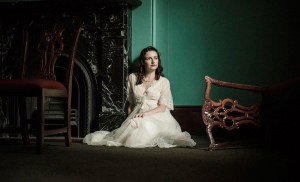theatre review: maureen o’hara spends a quiet night at home

Maureen O’Hara Spends a Quiet Night At Home began as a concept wonderful in its simplicity. Dramatising the photo series by Peter Stackpole of the same name, which in 1946 captured film star Maureen O’Hara during a “normal evening in”, the fifty minute performance piece gives the audience an intimate glimpse into the imagined private nightlife of O’Hara, a view both revealing and mystifying.
Director and solo performer Belinda Locke has the undeniable regal essence of a Golden Age film star; it’s there in her eyes during the entire performance of Maureen O’Hara Spends a Quiet Night At Home. There’s something about the way she holds herself, the way she moves, that quietly demands attention and respect from the audience. She has a confidence that comes from an acknowledged vulnerability that transfixes a viewer. Throughout the show, the character of Maureen seems to be saying to the audience, ‘Well, here I am, take me as you will,’ asking them to work to find their own story and meaning in this mute production.
It’s possible, though, that the show asks the audience to work just a little too hard. Missing from the production was the building of a clear relationship with the audience by either Locke or her character. More clarity in the relationship O’Hara had with the public and their encroaching on her private life would also have been an interesting addition, with all of these relationships needed to build the tension within the performance that was slightly lacking. At times Locke deliberately locked eyes with the audience, as though challenging them to something, but it wasn’t quite clear what. To look away, or to watch? To enjoy the moments when she was dancing in her bedroom, or to be embarrassed for her and look away? It’s all very meta-theatrical; Locke watching the audience watching the character of O’Hara watching herself projected on a cinema screen, and could be so very cleverly communicative if it was just a little more pointed. While sometimes such simple theatre can be overly didactic, the team of Maureen O’Hara Spends a Quiet Night At Home shouldn’t be afraid to delve deeper into the true crux of this story. With the advancement of technology, all of our lives are quickly losing elements of privacy and the question of what and who is authentic is constantly being raised. There could be a link made here which would take the audience beyond watching this piece of theatre to thinking with it, and that would make it truly great.
In terms of what an audience does experience, Maureen O’Hara Spends a Quiet Night At Home is highly aesthetically pleasing, playing not only with the visual senses, but with sound and smell, too. A soft 1940s jazz soundtrack plays throughout the piece, complete with the delicious crackling of a new record starting to play, and the scent of the bath soap Locke lathers herself in wafts gently to the audience throughout the performance. Carelessly fiddling with strings of pearls and dressing in soft chiffons and velvets, it’s an almost tactile experience for the audience who watch closely as Locke plays with the set elements. The design of the set, while small and reasonably simple, is very effective.
While there is further development to be done to make this a truly compelling piece of theatre, Maureen O’Hara Spends a Quiet Night At Home showcases some very worthwhile ideas and talented creatives. Locke and her team have put together a show significant in its simplicity, playing with concepts in an experimental way vital to the creation of new theatre.


I have been Maureen O’Hara’s archivist and published her official website “Maureen O’Hara Magazine” for almost 20 years It is very frustrating to me, being here in the United States, not being able to see the actual play after my years of research into Maureen’s life and career and have her as a personal friend. I understand that Maureen’s image is just used as a vessel of some kind to reflect on Hollywood classic movie days, but Maureen was never a “typical” starlet. She came to the US co-starring with Charles Laughton in “The Hunchback of Notre Dame” and remained here under contract to RKO when WW-2 prevented her from returning to Ireland. I am just curious to know if at any point in the play she has Maureen smoking a cigarette because she was a non-smoker and has been so her entire life.
I would like to read a review that tells me just what she talk about; does it sound like Maureen, etc. etc.